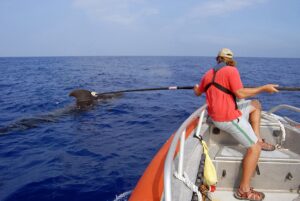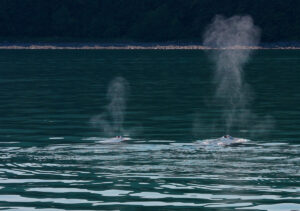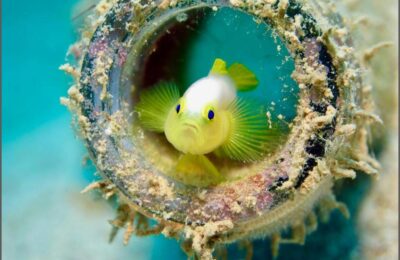Reference: Indeck, Katherine L., Michael J. Noad, and Rebecca A. Dunlop. “Humpback whale adult females and calves balance acoustic contact with vocal crypsis during periods of increased separation.” Ecology and Evolution 12.2 (2022): e8604. DOI: 10.1002/ece3.8604
Stealthy Sounds
The image of a mother whale and her calf swimming across the open ocean seems like a peaceful, serene vision. For the whales however, this large watery expanse can be fraught with danger. When a mother has a calf and needs to travel, usually to migrate to more habitable locations, she likely wants to do so quietly – if predators hear, they may attack, or if male whales spot the female, they may try to harass her to mate and put her calf in danger. This need for stealth conflicts with the mother and calf’s need to communicate. While baby whales tend to stay very close to their mothers, the mothers still need to sleep and dive for food for long periods of time, or at depths that their calves cannot reach. These different behavioral needs mean that these pairs are occasionally separated, and need to call out to each other when out of sight for safety. But how do mothers and calves balance the need to be quiet with the need to keep in contact? Researchers from the University of Queensland in Australia sought to answer this question.

Capturing Calls
Over the course of seven years, the researchers followed migrating humpback whale mother and calf pairs off the coast of Queensland, Australia, and placed acoustic tags on the mother whales. These tags were able to record the calls that both adult females and their calves made. They were also able to track when the mothers were diving and how deep they were going, as well as how far apart the mothers were from their babies. Using this information, the researchers were able to gauge two main swimming behaviors: resting and travelling. During resting, the whale mothers tended to make very long, deep dives while the calves rested at the surface. While travelling, the mothers made shorter length dives, and the calves followed along.
When resting, the pair would call to each other much more often than when travelling, likely because they were more often separated at rest, with the calves breathing at the surface. Interestingly, the calls when resting and travelling were both at the same decibel level, so calls did not get louder, even when mother and calf were further apart from each other. Even under the best of circumstances where there was minimal background noise, the researchers determined that mothers and calves could only hear each other from a maximum of about five miles away. More realistically however, calls between the pairs could only be heard from a little over a mile away.
Sadly Swelling Sounds
So what does all of this actually mean for these humpback whale pairs? Clearly, mothers and calves do not feel comfortable loudly calling to each other when separated for fear of being overheard by threats. Instead, they try and quietly call to each other repeatedly when out of sight. The pairs are more often separated at rest, which makes sense – during this time, the mothers are likely diving for food and sleeping below the surface, while the calves spend time recovering from travel and obtaining extra oxygen at the surface. When travelling, they stick tightly together so as not to lose each other. Because of these behavioral differences, the pair will communicate with each other more frequently during resting times.
The fact that most mother and calf calls cannot be heard from very far away may be helpful in hiding the location of these whales, but it can also spell bad news in an ocean that is becoming increasingly affected by human-made noise. Especially if swimming near a coast, the noise of shipping vessels and other human activities may prevent mothers and calves from hearing each other when separated. These distractions could cause the pair to lose each other completely, or be forced to call more loudly to find each other, alerting predators or other whales who may pose a threat. In the vast space that is the open seas, it can be a tough life for whale mothers and calves to survive, and we as humans should try not to make things harder for these valuable marine mammals.

I received my PhD in Biology from Wake Forest University, and I received a BS in Biology from Cornell University. My research focuses on the terrestrial locomotion of fishes. I am particularly interested in how different fishes move differently on land, and how one fish may move differently in different environments. While I tend to study small amphibious fishes, I’ve had a lifelong fascination with all ocean animals, and sharks in particular. When not doing science, I enjoy running, attempting to bake and cook, and reading.


